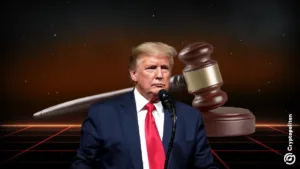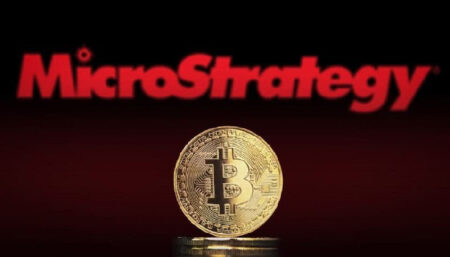To get the show every day, follow the podcast here.
On “Markets Daily,” host Jennifer Sanasie speaks with Anthony Moro, CEO of Provenance Blockchain Foundation, about the performance of recently launched spot bitcoin ETFs compared to the introduction of gold ETFs and the practical use of real world assets for traders and institutions.
–
Consensus is where experts convene to talk about the ideas shaping our digital future. Join developers, investors, founders, brands, policymakers and more in Austin, Texas from May 29-31. The tenth annual Consensus is curated by CoinDesk to feature the industry’s most sought-after speakers, unparalleled networking opportunities and unforgettable experiences. Take 15% off registration with the code MD15. Register now at consensus.coindesk.com.
This episode was hosted by Jennifer Sanasie. “Markets Daily” is executive produced by Jared Schwartz and produced and edited by Eleanor Pahl, alongside Senior Booking Producer Melissa Montañez. All original music by Doc Blust and Colin Mealey.
Audio transcript: This transcript has not been edited and may contain errors.
JENNIFER SANASIE:
Let’s start with what’s going on in the markets this morning. What are you watching?
ANTHONY MORO:
Yeah, so everyone’s watching the Fed. I think the volatility will continue until we have a clear path on what what they plan to do. That being said, I think digital assets are very early in the in the cycle, and we’re gonna see a lot of momentum building through the first quarter of the year.
JENNIFER SANASIE:
Let’s talk a little bit more about the Fed, it’s looking unlikely that there’s going to be rate cuts in March. What do you expect to see the Fed do this year? And how do you expect to see it affect the markets?
ANTHONY MORO:
Yeah, so while I’m personally not much of a Fed watcher, I do read the research that comes out from the big banks. And I do think we expect several rate cuts through the end of the year. I personally, believing in that as well. If you watch your personal mortgage rates, I think they’re going down pretty substantially, which will help bring capital back in to the ecosystem which can help all assets particularly the more speculative ones like crypto.
JENNIFER SANASIE:
It’s been a big year for institutional adoption. We of course, saw the approval of the spot bitcoin ETF in January. Talk to me about what you’re watching there. Are you hopeful that we’ll see a spot ETF? And how do you expect to see institutions adopt to crypto for the remainder of 2024?
ANTHONY MORO:
Yeah, so we were really delighted at Providence that the bitcoin ETF got approved by the SEC, it brings institutional credibility to crypto as an asset class for sure. And we have a lot more investors looking at the asset class as as ever. I like to think in financial services, you would always ask yourself, what would Willie Sutton do and who was Willie Sutton? Well, he was a famous bank robber back in the early part of last century. And when asked why he robbed banks, he said, because that’s where the money is. And the reason we saw bitcoin, the interest in bitcoin growing is because national exchanges are still where the money is in the financial markets. If you have the ability to access investors at Merrill Lynch and Morgan Stanley and Charles Schwab, through their everyday brokerage accounts, or their 401Ks or their IRAs, that’s where the money is. So we’re excited about the bitcoin ETF. Personally, I think we’ll see an ETH ETF and we’ll see a convergence between national exchanges and crypto exchanges over time. And all of this will be to the tune of taking fees out of transactions which goes back to the promise of blockchain which technology as a whole is deflationary. And I think we’re gonna see that as more ETFs come out, and then as crypto exchanges and national exchanges and it is all starting to converge.
JENNIFER SANASIE:
Well, speaking of fees, I want to talk about a note that came out this morning on CoinDesk. Leverage shares analysts said that bitcoin ETFs could pose some risks for Coinbase shares, because ETF fees are lower than the exchanges. Any perspective there. Do you think that Coinbase shares could be at risk on the back of these approvals?
ANTHONY MORO:
What I can say is, as I said, technology is deflationary. And particularly financial services is deflationary as well. What you see over time is fees come out of transactions, particularly in the digital space as we reduce the number of actors between a buyer and a seller. And that’s really the promise of blockchain. And where we set up Provenance is we try to reduce the amount of intermediaries for the benefit of the buyer and the seller. So for instance, what Coinbase is doing is they’re looking a lot like a regular New York Stock Exchange or NASDAQ, where the buyer and seller really don’t get to interact against one another. They have to use a broker, introducing broker dealer they have to as a custodian, they have to use an exchange. And then they have to use the same partners on the other side of that transaction. And each one of them takes a little bit of a fee out of what they do in exchange for safety and security, which is certainly important. But the promise of crypto particularly decentralized exchange is I can face off against you, Jenn, one on one, bilaterally, without the need for trust or without the need for having anyone else in the party because blockchain introduces truth to our transaction. And if we can face off against one another, we can do it at a price at a time of our choosing without any intermediaries and in that case, there’s no fuse for decentralized exchanges.
JENNIFER SANASIE:
Anthony, I have to ask you, I know you have had a long career in the traditional financial industry now with the approval of the spot bitcoin ETFs. A lot of folks were expecting to see the price of bitcoin soar on that approval. I know you can’t comment on price. But does this remind you of anything else you’ve seen in your career? That might give you some insight into why the price of bitcoin didn’t take off the way that some expected?
ANTHONY MORO:
Yeah, I think it was more buying the rumor sell on the news, of course. But also I’d add that almost 20 years ago I was at BNY Mellon when we were the trustee for the first gold ETF. And I think exactly the same thing happened as there was anticipation that gold would be made liquid for the first time by an ETF. It had the same and similar price dynamics. I think people bought on the rumor, and then they sold on the news. But again, we’re in the early stages of the first inning of digital assets trading on a national exchange, I wouldn’t look to anything short term, you have to look at this over a period of months, if not years to see what the effect of having bitcoin on a national exchange will do to the asset. And I’ll just add, unlike gold and many other assets, bitcoin has a fixed supply, they’re not making any more of it. And if you have more investors and a fixed supply, you know, economics says you know, price should increase because of that.
JENNIFER SANASIE:
I know over at Provenance, you’re focused on real world assets just unpack for me, what the introduction of real world assets means for traders in the tradfi realm, and crypto native traders, how’s it kind of bridging the gap between the two.
ANTHONY MORO:
I’ll just give you one example. So home equity line of credit is the only asset class in my opinion to have ever been disrupted by a public blockchain. And I’ll unpack that a little bit. Today figure and 10 of the 20 largest home equity line of credit originators operate on the Provenance blockchain today. And they do it because it’s more efficient. And what they when they ledger alone, they can warehouse it and securitize it to the tune of about 150 to 250 basis points cheaper than if they did it in the tradfi, existing tradfi manner. what this can do at the end of the day is put money back into borrowers pockets, which we find incredibly exciting, but the process is significantly more efficient. And as I mentioned, technology is deflationary, and allows investors to access home equity in a cheaper and more efficient manner than they could without blockchain. And this opens up a ton of investment opportunities for everyone in the crypto block in the crypto space in terms of perfecting the assets, winning the assets, and then a secondary market trading of the assets. So, in our world, blockchain is very much about tokenizing financial assets. And if you think the world of financial assets is about $700 trillion dollars, compared to about one or $2 trillion of crypto assets, we’re keeping our eyes on the prize, the big $700 trillion number and I’m not saying we’re gonna tokenize all that tomorrow. It’s gonna happen asset class by asset class over a long period of time. But we’re working hard every day to make that happen.
JENNIFER SANASIE:
All right, and Anthony quickly before we go, we are at February now, it feels like January just kind of zipped by, what what are you watching for the rest of 2024. For all of our traders, investors who are listening to this show, what do you watch it? What kind of insight can they get from you?
ANTHONY MORO:
Well, we had some dark times in the industry over the last couple of years, but I think now that interest rates are moving in the right direction. I do see a return to higher asset prices and certainly lower inflation. The Fed has somehow miraculously pulled off its soft landing, probably, in real interest rates are lower than what the Fed believes, I believe. So I’m looking for asset prices across the board to increase. Personally that’s where I’m betting and then I’m looking for Provenance to lead the charge in terms of real world assets on chain.
JENNIFER SANASIE:
Anthony, thanks so much for joining us this morning. That was Provenance blockchain foundation CEO Anthony Moro. That’s it for today’s show.
Read the full article here








